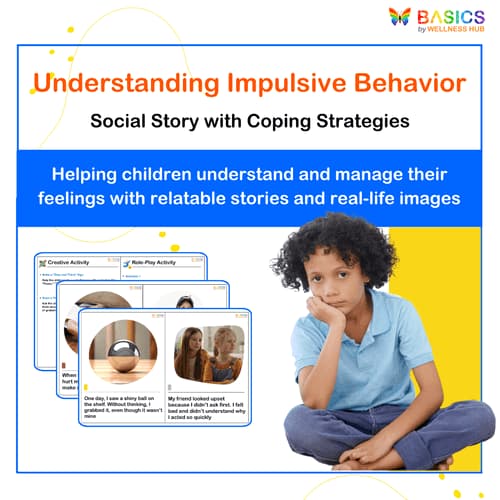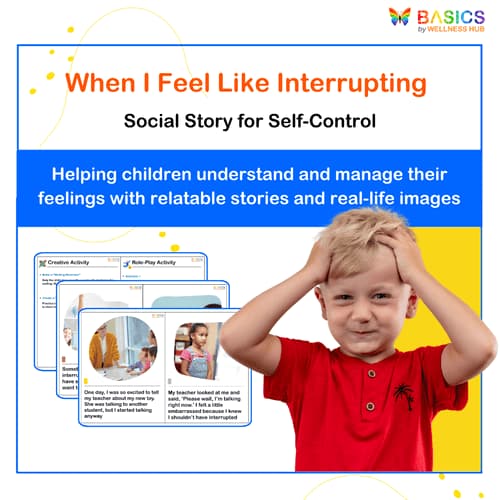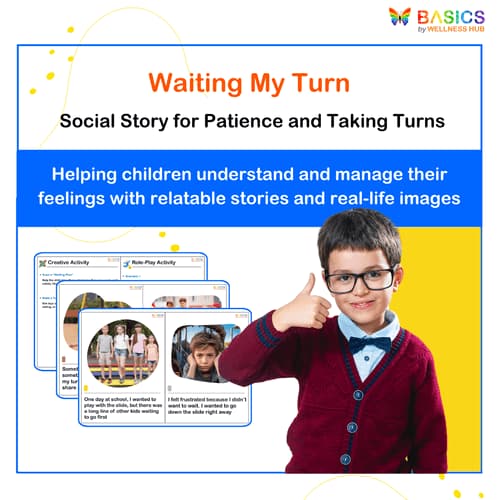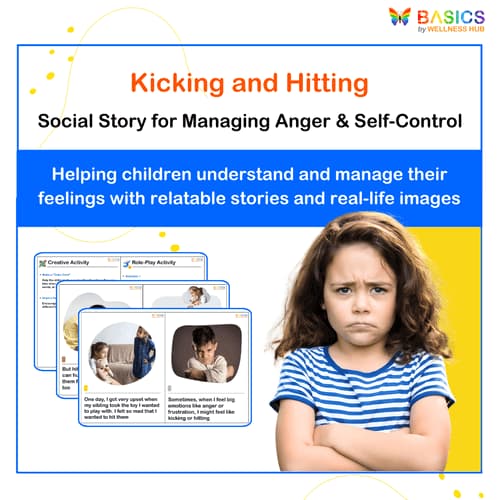





Coping with Fear: A Social Story for Children
₹80
₹160
50% off
0 (0 ratings)
Grade Levels
Pre-K - Grade 2 (Ages 3-7)
Content Overview
1 PDF, 6 pages with real-life images, 12 scenarios, 2 statements per page Features Segment: High-quality real images, engaging first-person narrative, child-friendly approach.
Categories
Pages from the Resource
Help your child cope with fear using this engaging social story featuring relatable scenarios and real-life images. With simple language and comforting strategies, this story guides children on how to recognize and manage their feelings of fear, making it a perfect resource for parents, educators, and therapists.

Page 1

Page 2
What Users Say
0
0 ratings
5
0+
4
0+
3
0+
2
0+
1
0+
5 Stars
Product is Good to use.
10 months ago
Varsha Parent
Similar Products

Understanding Impulsive Behavior: Social Story with Coping Strategies
₹ 80.00
₹ 160.00
50% off
4.9 (42 ratings)

When I Feel Like Interrupting – Social Story for Self-Control
₹ 80.00
₹ 160.00
50% off
4.8 (60 ratings)

Waiting My Turn – Social Story for Patience and Taking Turns
₹ 80.00
₹ 160.00
50% off
4.7 (56 ratings)

Kicking and Hitting – Social Story for Managing Anger & Self-Control
₹ 80.00
₹ 160.00
50% off
4.6 (52 ratings)

Understanding Swear Words – Social Story for Respectful Communication
₹ 80.00
₹ 160.00
50% off
4.9 (48 ratings)
About the Product
Purpose of Flashcards: The "Coping with Fear: A Social Story for Children" resource is designed to help young children navigate and understand their fears in a relatable and gentle manner. Using first-person narrative and high-quality real images, this social story presents a situation where a child experiences fear and demonstrates coping strategies to manage it. The structured, sequential narrative and realistic imagery make the content engaging and easy for children to connect with, allowing them to develop better emotional understanding and resilience. This resource is ideal for parents, educators, and therapists looking to introduce strategies for managing fear in a supportive, child-friendly format.
Product Details
Format: 1 PDF file
Total Pages: 6 pages
Content Overview: The PDF contains a detailed social story presented across 12 segments, each with accompanying high-quality real images. The story is told in a first-person narrative to help children easily relate to the experience and visualize the coping strategies discussed.
Features: Engaging storyline, high-quality images, step-by-step coping strategies, designed for easy understanding.
Educational Benefits
Emotional Awareness and Regulation: The story helps children recognize fear as a normal emotion and introduces them to practical strategies like deep breathing, positive visualization, and talking to trusted adults. This promotes healthy emotional development and self-regulation.
Empathy and Relatability: By using a first-person narrative and realistic images, children can easily put themselves in the character’s shoes, which enhances their understanding of emotions and builds empathy.
Problem-Solving Skills: The story guides children through identifying a problem (fear) and using logical steps to resolve it, thereby fostering critical thinking and problem-solving abilities.
Social-Emotional Learning (SEL): The resource aligns with SEL principles by addressing core areas like self-awareness, emotional expression, and social communication, making it suitable for both neurotypical and neurodiverse children.
Instructions for Use
Reading the Story: Begin by introducing the concept of social stories to the child, explaining that it is a special type of story that helps them learn how to handle situations that might feel challenging. Read the story aloud to the child, encouraging them to engage with the images and ask questions.
Interactive Discussions: After reading each segment, pause and discuss the scenario with the child. Ask them how they would feel or react in similar situations and encourage them to explore the coping strategies presented in the story.
Practice and Reinforcement: Use the story as a tool to practice the coping strategies in real life. For example, if the story mentions deep breathing, guide the child through a breathing exercise when they feel anxious or scared.
Visual and Tangible Reinforcement: Since the images are realistic, children can use them as visual cues to recall strategies when they face fearful situations. Parents and educators can also point to the images as a reminder of what the child learned in the story.
Revisit the Story Regularly: The effectiveness of social stories lies in repetition. Revisit the story whenever the child encounters fear-inducing situations to reinforce the learning and make the coping mechanisms second nature.
Activities Using the Resource
Role-Playing Scenarios: After reading the story, create role-playing scenarios with the child where they pretend to experience similar fearful situations. For example, act out hearing a strange noise and practice using the coping strategies presented in the story, such as deep breathing, positive thinking, or seeking comfort from a trusted adult. Role-playing helps children internalize and apply what they have learned in real-life situations.
Emotion Mapping: Create an emotion map by discussing different scenarios from the story and asking the child to identify how they felt during each situation. Use visual aids like colored emotion cards (e.g., blue for calm, red for scared) to help the child express their feelings. This activity encourages emotional recognition and helps the child articulate their emotions.
Coping Strategy Chart: Make a coping strategy chart where the child lists or draws the different strategies they learned from the story (e.g., deep breathing, hugging a teddy bear, using a night light). Place this chart in their room or classroom as a quick reference whenever they feel scared.
Art Therapy: Encourage the child to draw or color scenes from the story or create their own version of a "happy place" they can imagine when they feel scared. This creative expression helps them connect with the strategies and visualize positive outcomes.
Storytelling Extensions: After reading the story, ask the child to create their own ending or extension to the story. They can imagine new situations where they might feel scared and describe how they would use the coping strategies. This activity promotes creative thinking and reinforces the application of the concepts in other scenarios.
FAQs
Q1: How often should I read the social story to my child?
A1: Consistency is key. It’s recommended to read the story regularly, especially before bedtime or when the child feels anxious. Repetition helps reinforce the strategies, making them easier to recall during real-life situations.
Q2: Is this story suitable for children with special needs?
A2: Yes, the story is designed to be inclusive and effective for both neurotypical and neurodiverse children. The use of first-person narrative and real images makes it relatable and engaging for children with developmental delays, Autism, or anxiety.
Q3: Can the story be customized to fit my child’s specific fears?
A3: While the story is designed as a general guide, you can discuss personalized scenarios with your child during interactive discussions. Encourage them to apply the coping strategies to fears they encounter in their daily life.
Q4: What age group is this resource most suitable for?
A4: This resource is best suited for children aged 3 to 7 years old. However, older children who experience fear or anxiety can also benefit from the strategies presented in the story.
Q5: Can I share this story with my child’s teacher or therapist?
A5: Yes, you can share this resource with educators and therapists who work with your child. However, the story is for personal and classroom use only and cannot be reproduced for commercial purposes.
Usage Rights and Restrictions
Personal and Classroom Use: This resource is intended for personal use at home or in a single classroom setting. It may be shared with direct caregivers, educators, or therapists working with the child, but it cannot be reproduced, distributed, or sold without proper authorization.
Reproduction Restrictions: You may print the PDF for personal use or use in your classroom, but copying, redistributing, or uploading the content to other platforms is strictly prohibited. Each purchase grants usage rights to one household or classroom.
Commercial Use Prohibited: The content is for educational purposes and cannot be used for commercial gain or distributed as part of a paid program without prior consent from the creators.
Conclusion
Thank you for choosing our "Coping with Fear: A Social Story for Children" resource. We are confident that this tool will empower your child to manage their fears and build resilience. By regularly engaging with the story and its activities, children will develop emotional awareness and learn valuable coping skills that will benefit them in various situations. We wish you and your child success on this journey toward overcoming fear with confidence and positivity!



